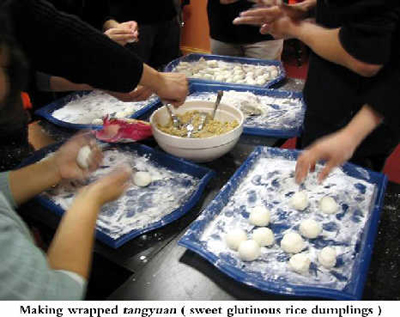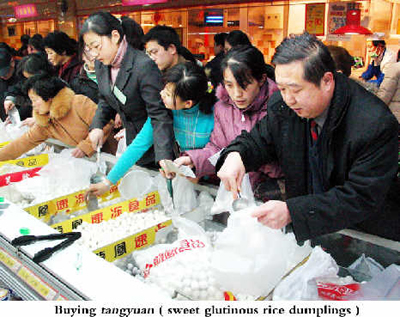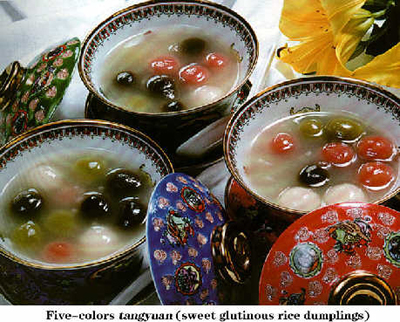The Lantern Festival falls on the 15th day of the 1st lunar month, usually in February or March on the Gregorian calendar. As early as the Western Han Dynasty (206 BC-AD 25), it had become a festival with great significance.
This day's important activity is watching lanterns. Throughout the Han Dynasty (206 BC-AD 220), Buddhism flourished in China. One emperor heard that Buddhist monks would watch sarira, or remains from the cremation of Buddha's body, and light lanterns to worship Buddha on the 15th day of the 1st lunar month, so he ordered lanterns to be lit in the imperial palace and temples to show respect to Buddha on this day. Later, the Buddhist rite developed into a grand festival among all citizens and its influence expanded from the Central Plains to the whole of China.
In modern times, the lantern festival is still held each year around the country. Lanterns of various shapes and sizes are hung in the streets, attracting countless visitors. Children will hold self-made or bought lanterns to stroll with on the streets, extremely excited.
"Guessing lantern riddles" is an essential part of the Festival. Lantern owners write riddles on pieces of paper and post them on the lanterns. If visitors have solutions to the riddles, they can pull the paper out and go to the lantern owners to check the answers. If they are right, they will get a little gift. The activity emerged during people's enjoyment of lanterns in the Song Dynasty (960-1279). As riddle guessing is interesting and full of wisdom, it has become popular among all social strata.
In the daytime of the Festival, performances such as a dragon lantern dance, a lion dance, a land boat dance, a yangge dance, walking on stilts, and beating drums while dancing will be staged. On the night, in addition to magnificent lanterns, fireworks form a beautiful scene. Most families save some fireworks from the Spring Festival and light them during the Lantern Festival. Some local governments will even organize fireworks parties. On the night when the first full moon enters the New Year, people get lost in the celebration with the imposing fireworks and bright moon in the sky.
People will eat
yuanxiao, or rice dumplings, on this day, so it is also called the "
Yuanxiao Festival." Yuanxiao also has another name, tangyuan. These are small dumpling balls made of glutinous rice flour with rose petals, sesame, bean paste, jujube paste, walnut meat, dried fruit, sugar and edible oil as filling. Tangyuan can be boiled, fried or steamed. It tastes sweet and delicious. What's more, tangyuan in Chinese has a similar pronunciation with "
tuanyuan," meaning reunion. So people eat them to denote union, harmony, and happiness for the family.
Legend has it that yuanxiao date back to China's Spring and Autumn Periods. During the Tang Dynasty they were called mianjian (flour cocoons) or yuan bu luo ni. During the Song Dynasty they were called yuanzi (spheres) or tuanzi (dumplings).
There are many different types of yuanxiao, with fillings covering the entire range of the Five Flavors (savory, spicy, sweet, sour, and salty). Sweet fillings are the most common, and include sweet bean paste, sesame, date paste, ginkgo nut, peanut, almond, and hawthorn fruit. Other fillings include pickled cabbage, minced pork, minced ham, shrimp, green beans, and chrysanthemum. There are two methods for making yuanxiao - wrapping and rolling. Wrapped yuanxiao are called tangyuan, and are popular in southern China. Tangyuan are assembled by making a depression in a ball of glutinous rice flour dough, inserting the filling into the depression, and then sealing the ball. Rolled yuanxiao are popular in northern China. Assembly consists of rolling a small ball of the filling in dry glutinous rice flour, building it up like a snowball until it reaches the desired size. The completed yuanxaio and tangyuan may be boiled, steamed, or deep-fried.
With the approach of Lantern Festival,
yuanxiao can be seen everywhere, further heightening the festive holiday spirit. The round shape of yuanxiao symbolizes the family circle, and eating
yuanxiao symbolizes the hope for family reunions.
Yuanxiao are not only a traditional holiday food, but also were used to express respect for the deities. Their round shape also represents perfection and unity. Accord to a Taiwanese folk saying, "Eating
tangyuan leads to reunions."
Eating yuanxiao at home is only one part of Lantern Festival. Even more important is the tradition of attending temple fairs or street fairs and viewing lantern displays.
Many Chinese holidays involve lanterns, but the Lantern Festival represents the epitome of this custom. Lanterns are first brought out on the thirteenth day of the first lunar month. They are tested on the fourteenth, formally lit on the fifteenth, and taken down on the eighteenth. The origins of Chinese lanterns reach back to the Stone Age. The coming of the Bronze Age saw the development of various kinds of worked metal lanterns, of which palace lanterns were the most ornate. Later, decorative lanterns came to be used in festivals. Various lantern festivals became quite popular during the Sui Dynasty, and during the Southern Song Dynasty, the custom of writing riddles on lanterns emerged. During this time, a festival in Qinhuaihe in Nanjing featured over 10,000 lanterns. During the Qing Dynasty, magnificent exhibitions of lanterns were held in the capital city. Lantern contests were also held, with the dragon lantern being the most famous competitor. Beijing also had a famous lantern market, while southern China was known for shows of lanterns on rivers and lakes. Ningxiang County in Shanxi Province was known for its "Mountain Festival of Lights," during which the mountainside was covered with a festive display of 10,000 lanterns. These festivals not only provided a beautiful show of multicolored lanterns, but also featured a wide range of folk art and performances, such as the Lion Dance, Dragon Lantern Dance, stilt-walking, land-boat racing, and Yangge dancing.
 |
 |
 |
 |
 |
(China.org.cn February 13, 2007)
